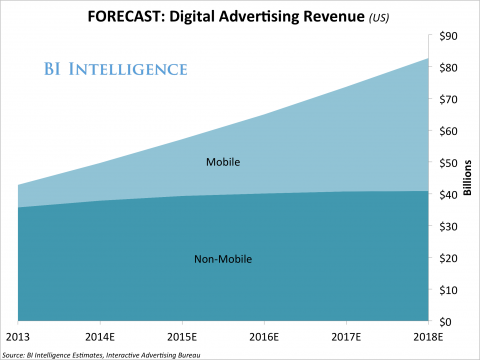The role of mobile app data in driving revenue

Rational exuberance, irrational exuberance, or both?
“In God we trust. All others must bring data.” – W. Edwards Deming
The landscape of solutions that support your mobile app revenue efforts is, well, complicated. One look at the Mobile Lumascape Slide alone is enough to make many app owners crack open their favorite meditation app and seek their center. Things are evolving so rapidly that it can seem impossible at times to make the right choices for your business that will lay the proper foundation for growth & sustainability. Are you fated to be stuck in a perpetual cycle of adding new SDKs, trying out new tools, going from one monetization and marketing services solution to another and already in tech debt when your mobile journey is only just beginning? This is a legitimate challenge facing many businesses for whom success in mobile is critical.
When it becomes hard to make sense of the ecosystem around you, it’s all the more important to turn to the data. Because one thing is for sure: your ability to leverage data will be strongly correlated with your chance of success. Yes, this is about making data-driven decisions. But this is also about how you collect and leverage YOUR data. Exerting ownership over your app data is something fully under your control. Solving for how mobile will evolve is a moving target. You can and should solve right now for how you collect, control, and leverage your mobile app data.
In this post, I’ll talk about using your mobile app data in a very specific way: driving revenue.
Show me the data!
Data you collect in your app is called first-party data. That means you are responsible for its collection, stewardship, and usage. Installs and upgrades, user identities and profiles, event data, crash data, push notifications, location tracking – every data point that you generate in your app is your first party data.
And hopefully, you’ve embarked upon an instrumentation strategy that ensures all your data is people-centric. There are four primary ways to leverage your first party app data:
- Targeting: segment your users for engagement targeting such as push notifications, email, and various flavors of targeted advertising.
- Analytics: use your data for cohort, retention, marketing effectiveness, or other analytics.
- Personalization: use your data to deliver personalized experiences to your users.
- Product Improvement – leverage A/B test data and other forms of data to improve your app experience and user engagement.
Depending on your business needs, some of these scenarios can become quite complicated and interrelated and all can come into play for effective mobile revenue generation.
Driving mobile revenue
Using app data to drive mobile revenue entails 5 high-level steps:
- Collect app data
- Segment users
- Deploy revenue-generating strategies against targeted user segments
- Evaluate effectiveness of targeting & revenue generating strategies
- Optimize and repeat (put simply, do more of what’s working and less of what’s not)
Collect app data
For many app owners, there’s a failure to launch because they aren’t collecting and owning their own data. They are sending it off to analytics services, push notification services, attribution services, various other marketing solutions services, crash reporting services – everywhere else but to themselves! Collecting and maintaining your own first-party data is a crucial first step.
Segment users
Forrester reports that few marketers are aligning their mobile strategies to how customers are actually using smartphones today. Unless corrected, this will have significant repercussions as the disruptive mobile wave crashes forward. This is fundamentally about understanding your users and creating meaningful segments of your users. For revenue generation, this requires you identify and segment your users into classifications that allow you to deliver highly targeted and personalized messaging.
3. Deploy revenue-generating strategies against targeted user segments
Finally – we’re actually talking about driving revenue! What we’ve really been talking about up to this point, is laying the mobile app data groundwork for effective revenue generation. Let’s review the major mobile app revenue generation strategies and how data makes a difference.
 Drive mobile app revenue through advertising. BI Intelligence reports that mobile advertising is exploding and will grow much faster than all other digital advertising categories. Display and video will be the fastest-growing subcategories within mobile. One interesting tidbit: in-app mobile ads perform dramatically better than mobile web ads. This makes in-app advertising formats especially compelling to marketers because, with the balance of mobile time spent in mobile apps versus mobile web, advertisers achieve the win-win of both reach and performance via in-app advertising. Advertisers are looking to position their brand to specific audiences or drive an outcome from specific audiences. Your ability to deliver against those audiences will determine in large part the effectiveness of your monetization efforts via advertising. In addition, phone sensors are becoming increasingly sophisticated and starting to usher in the era of pervasive instrumentation. Properly capturing and leveraging this wealth of data has important implications for advertising.
Drive mobile app revenue through advertising. BI Intelligence reports that mobile advertising is exploding and will grow much faster than all other digital advertising categories. Display and video will be the fastest-growing subcategories within mobile. One interesting tidbit: in-app mobile ads perform dramatically better than mobile web ads. This makes in-app advertising formats especially compelling to marketers because, with the balance of mobile time spent in mobile apps versus mobile web, advertisers achieve the win-win of both reach and performance via in-app advertising. Advertisers are looking to position their brand to specific audiences or drive an outcome from specific audiences. Your ability to deliver against those audiences will determine in large part the effectiveness of your monetization efforts via advertising. In addition, phone sensors are becoming increasingly sophisticated and starting to usher in the era of pervasive instrumentation. Properly capturing and leveraging this wealth of data has important implications for advertising.- Driving mobile app revenue via in-app commerce. In-app commerce involves charging for products and/or services within the app. eCommerce, content distribution, gaming, and tiered service levels are all classic examples. This is another area where understanding your user and delivering targeted messages such as promotions and recommendations are critical for driving monetization. Collecting purchase data, shopping cart funnel data, and user behavior data are essential for understanding your users, properly segmenting those users, and then delivering highly targeted and personalized in-app engagements such as push notifications, dynamically displayed content, and so on.
- Driving mobile app revenue via paid apps. Of course, you can also charge for your app. Even here your existing app data can be beneficial. Creating a segment of your highly engaged or high “lifetime value” users, pushing that segment to Facebook, creating a Facebook lookalike audience from that segment, and then running a Facebook app install campaign that targets your lookalike audience is simply one example with one media provider; the options here are proliferating.
- Mobile revenue generation via audience monetization. Some app owners anonymize their first-party data and monetize that audience by shipping app data and/or user segments to audience data marketplaces. This comes with significant pros and cons because although the data is anonymized, you are sending it to an external data source to steward and monetize on your behalf. If you sell advertising, an alternative way to monetize your audience is via a strategy known as audience extension. For example, let’s say you are an app owner with an audience that is highly desirable for marketers, and so you’ve effectively “sold out” your in-app inventory. You can choose to make those segments available beyond your own app and allow marketers to target your audience across a network of apps and/or websites.
4. Evaluate effectiveness of targeting & revenue generating strategies
On a recent earnings call, Kraft’s CFO made a statement that caught a lot of marketers’ attention: “We’re not looking to drive down advertising costs per se. We’re driving for improved advertising effectiveness. We’re also realizing meaningful efficiencies as we shift our spending to more targeted digital media.”
It may seem obvious, but understanding the actual effectiveness of a given marketing strategy and making proper decisions as a result, is actually one of the biggest challenges that a marketer faces. If you are not in control of your own data, you don’t stand a chance. So how well did each monetization and segmentation strategy perform for you? If you are selling advertising, how well did it perform and scale for the advertiser? Which assumptions were validated, which assumptions were bad? How can you tell? What does it mean for what you do next?
5. Optimize and repeat
Once you evaluate what is working and what is not working, it’s time to optimize. Refine strategies and segmentations that are working well, prune those that are not, test hypotheses by trying out additional strategies. Repeat.
Summary
“Data is the new oil!” – Clive Humby
Your data should fuel your mobile content and monetization strategies. Properly collecting and exerting ownership of your data is the first step in that process.
This is particularly foundational for mobile because the explosive rate of change has put many app owners and marketers in a reactive posture. Rather than securing their data assets as a proactive measure, many have simply responded to market forces by trying one service after another in order to drive user engagement and mobile monetization. Turn to the data. Take control of your mobile future and realize the benefits of leveraging your app data for mobile monetization.
“Data is the new oil? No: Data is the new soil.” – David McCandless
Latest from mParticle
Try out mParticle
See how leading multi-channel consumer brands solve E2E customer data challenges with a real-time customer data platform.
Startups can now receive up to one year of complimentary access to mParticle. Receive access




